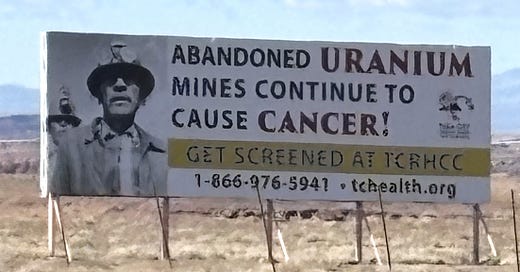When you drive through Arizona on highway 89 from New Mexico, you drive straight through Navajo Dine land. It is sparse, and cellphone service is spotty at best, and you will rarely see a single billboard for anything other than souvenirs and roadside attractions. This was notable to me, because as an Illinoisan I see billboards constantly, about everything from adult toys to hair growth formulas. There is one billboard, however that sticks out: it features an old Navajo man, looking up towards the sky, with text stating “Abandoned uranium mines continue to cause cancer”, accompanied by a phone number for cancer screenings.
Uranium is arguably one of the most dangerous and widespread issues in the Southwest, and yet it is the scorpions, the snakes, the sun that we are warned about. Uranium mines in the region were not properly cleaned up when mining was finished, and the residue in the mines causes cancer on the reservation to this day. I pass these billboards when I drive to Sedona, about 2-and-a-half hours away from where I live on the Utah-Arizona border. Entering Sedona feels like a different place: it is greener, due to the Coconino National Forest and the higher elevation. But the starkest difference between Navajo nation and Sedona is the health. Sedona, and the forest, are home to several different “vortexes” that are supposed to cause wellness. In downtown Sedona, shops advertise chakra aligning crystals, aura photography and holistic medicine, and there are too many yoga studios to count. It is in Arizona that you see in only a matter of miles how different health is for disenfranchised people in the US.
Health and wellness are commonly labelled as the same; after all, working out is a wellness factor that makes for good health, and a good night’s rest is as much wellness as it is health. Health of community can be summarized in many ways: diet, access to nutritional food and grocery stores, walkability, medical care and insurance, and wealth. In New Age wellness, health is gold.
On Navajo Nation, the media home value is 63,500 dollars; 70 percent of homes are valued less than 100,000 dollars. In Sedona, the average home value is 935, 619 dollars. Treating anything more than a broken arm on Navajo Nation requires a helicopter trip to Flagstaff; Sedona has a hospital in the region and is a half hour from Flagstaff driving.
There are other signs I notice in my drive from Page to Sedona. On Navajo Nation, a sign informing onlookers to vote for Kamala Harris for President and Ruben Gallego for Senate. Driving around residential Sedona, even in late April, houses have “Trump 2024” flags outside. It seems antithetical, to vote for a man who serves McDonalds (think of the red-40!) instead of a woman who exercises. That’s the open secret in the wellness world- Trump is better for wellness. Sedona wellness is focused on spiritual fixes- herbal remedies, vortexes, chakras, yoga. It is the mix of appropriation of South Asian traditions with a healthy dose of wealthy white womanhood. They don’t use vaccines, and if they do they are skeptical of them. They blame illness on lack of vitamins, and refused to mask up during COVID. Sedona wellness is indicative of the trendy and tradwife wellness that TikTok so graciously gifted the world. A billboard on Navajo Nation implores viewers to get vaccinated.
Robert Kennedy Jr. is now head of Health and Human Services (HHS). Amidst a deadly measles outbreak in Arizona’s neighboring states of Texas and New Mexico, Kennedy propogated a cure using cod liver oil and vitamin A. On March 20, Trump signed an Executive Order to increase mineral mining in the US- including uranium. In the days after, the US fast-tracked Laramide Resources Ltd. uranium mining project, located near Navajo land in northwest New Mexico. The site is mere miles away from the 1979 Church Rock Mill spill, the largest nuclear disaster in US history.
A month prior to the mineral mining EO, Trump created the “President’s Make America Healthy Again Commision”. The EO specifically details the “potential over-utilization of medication, certain food ingredients, certain chemicals, and certain other exposures pose to children” and the “prevalence of.. prescription of selective serotonin reuptake inhibitors, antipsychotics, mood stabilizers, stimulants, and weight-loss drugs” as threats for the commission to tackle. Yet whose health is a concern to the Trump Administration is hardly obscured. Trump made it a goal to dismantle the Affordable Care Act during his first term, and under his HHS Secretary scientific health has been reduced to mere opinions and New Age ideas perpetuated on blogs and social media. Only a certain sect of Americans are included in MAHA, it seems.
Passing Cameron, Arizona on the way back to Page, I passed graffiti: “Radioactive pollution kills. It’s time to clean up the mines.”





